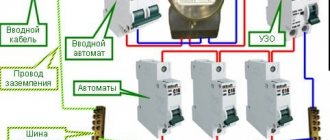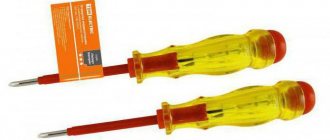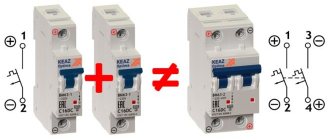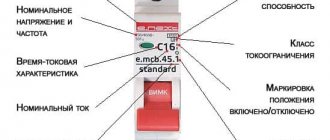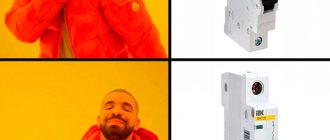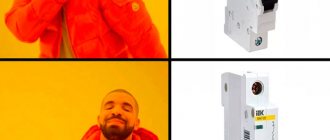Switching circuit of the introductory machine
Connection diagram
When connecting an input machine, it is important to follow the rule that the common cable is connected to the upper terminals, and the taps must be made from the bottom. To determine the points for supplying the power cable cores, you will need to find contacts marked F1, F2, F3 and the neutral wire N
In the absence of special markings, the buses are connected to the contacts in ascending order of their number when counting from left to right along the comb. In a 4-pole device, the first three will be phase, and the next one after them will be earth. In a 2-pole analogue, the first one on the left is phase, and the next one after it is zero.
The location where any input device is included in the general power supply circuit remains unchanged. It is installed at the very input of the supply circuit up to the sealed electric meter. After it, it is allowed to install a protective shutdown device of the second stage of operation, which improves the quality of protection against electric shock. It is more convenient to install additional automatic devices and RCDs on a common DIN rail located in the distribution cabinet next to the meter.
Is it necessary to install the machine on the neutral wire?
Is it possible to break zero automatically?
Many people begin to ask themselves this question when they begin to choose an input circuit breaker. Should the neutral conductor be connected to a circuit breaker or directly to the neutral bus? We will look for the answer to this question in the PUE. You don’t need to leaf through this thick book at all, since you can find out the answer in this article. Also here are links to the relevant paragraphs of regulatory documents. To be able to disconnect the neutral conductor together with the phase conductor, 2-pole (in a single-phase network) and 4-pole (in a three-phase network) circuit breakers are used.
In order to decide whether it is possible to break the zero automatically in your situation, you need to look at what kind of grounding system is used in the house.
First, let's get acquainted with paragraph 1.7.145. PUE:
It is not allowed to connect switching devices in circuits of PE and PEN conductors, with the exception of cases of powering electrical receivers using plug connectors.
It is also allowed to simultaneously disconnect all conductors at the input to electrical installations of individual residential, country and garden houses and similar objects fed by single-phase branches from overhead lines. In this case, the division of the PEN conductor into PE and N conductors must be carried out before the input protective switching device.
The PEN conductor combines a zero working N and a zero protective PE conductor all the way from the power source. This is a TN-C grounding system.
How to identify it at home? Look into the distribution panel and if the input is 2-wire, then you have TN-C. There is no third separate ground wire. It has been used before and is found in Soviet-built houses.
In this situation, the PUE is prohibited from breaking zero automatically.
Although, with such a grounding system, you can still pass zero through the machine if your property (private house, cottage, etc.) is powered by a single-phase branch from the power line, provided that the PEN conductor is separated to the machine. Here we already have a 3-wire network.
If your house has a TN-S grounding system. This is when the N and PE conductors are separated into independent conductors all the way from the power source.
How to identify it at home? Look into the panel and if the input is 3-wire (in a single-phase network) or 5-wire (in a three-phase network), then you have TN-S.
In this situation, clause 1.7.145. The PUE prohibits automatic tearing of only the PE grounding conductor. Therefore, the neutral conductor can be connected to a circuit breaker.
If protection is carried out not by automatic switches, but by fuses, then look at paragraph 3.1.17 in the PUE.
When protecting networks with fuses, the latter must be installed on all normally ungrounded poles or phases. Installation of fuses in neutral working conductors is prohibited.
Just keep in mind that “N” on different circuit breakers is prohibited. They need to be connected to only one device, which ensures that both conductors are disconnected simultaneously. This is stated in paragraph 3.1.18. PUE.
Releases are allowed to be installed in neutral conductors, provided that when they are triggered, all live conductors are disconnected from the network at the same time.
As you can see, “allowed” does not mean “necessary”. Therefore, decide for yourself whether you need to break the zero automatically in the TN-S grounding system.
I would also like to note the recommendations of the PUE set out in paragraph 7.1.21.
When supplying single-phase consumers from a multiphase supply network with branches from overhead lines, when the PEN conductor of the overhead line is common to groups of single-phase consumers powered from different phases, it is recommended to provide protective shutdown of consumers when the voltage exceeds the permissible limit, arising due to load imbalance when broken PEN conductor. The disconnection must be carried out at the entrance to the building, for example, by influencing the independent release of the input circuit breaker using a maximum voltage relay, and both the phase (L) and neutral working (N) conductors must be disconnected.
For example, a street of several private houses is powered from one overhead line with a combined zero working and zero protective conductor PEN. Several houses are connected to one phase, several houses to another phase, etc. If the PEN conductor, common to all, breaks, the voltage may exceed, since the load on the phases is not uniform. In such a situation, the PUE recommends protecting against voltage surges using a voltage relay, while L and N should be turned off at the same time.
Once a master and a trainee went to repair damage to a high-voltage cable. They came and looked: the cable was plowed up, the wires were twisted. Master: “I’ll put a crowbar between the veins, and you hit them with a sledgehammer so that they straighten out.” - Got it? - Hit! The trainee swung his hand and struck the helmet master with a sledgehammer. The master, naturally, left the hooves. - Uncle, forgive me, I didn’t do it on purpose, I didn’t mean to, I missed, I won’t do it again. Master (with 5 kopecks of sleepy eyes): - What bastard turned on the current?!
Why is it unacceptable to install a circuit breaker on the neutral wire?
I corresponded via email with Volodymirom about the inadmissibility of installing a circuit breaker on the neutral wire of the electrical wiring. For those who want to understand the intricacies of this issue, I think its result will be useful.
Volodymyr: I’m currently making an electrical panel in the apartment and a question has arisen. Why can’t separate machines be set to zero and phase, but only paired ones? Why “It is strictly prohibited to install a single circuit breaker on the neutral wire.”?
Answer: When installing separate circuit breakers on the neutral and phase wires, designed for the same protection current, in the event of an overload of the electrical wiring, only one of them is likely to work. This is due to the fact that circuit breakers have a variation in the magnitude of the operating current.
If the machine installed on the neutral wire is triggered, then all electrical wiring, including the neutral wire, will be under phase voltage. The phase will reach the neutral wire through electrical appliances that are turned on at this time, for example, a TV in standby mode, a refrigerator. And if a person thinks that since the machine has worked, it means that the wires are de-energized and, therefore, safe, then he can start repairing the electrical wiring and accidentally come under dangerous voltage.
That's why it's impossible. It is possible to install twin circuit breakers in household electrical wiring, but there is no point in this, only extra costs, since a paired circuit breaker costs much more. Therefore, the neutral wire is laid directly, and a machine must be installed on the phase wire.
Volodymyr: If during a short circuit the zero-machine is knocked out faster, and the phase-man-earth short circuit continues, then the phase-machine will still be knocked out. Also, both can work approximately simultaneously. That is, the machine must be set to zero more powerful than the phase one. But there will be no disruptions to the network, only additional costs.
You can, of course, install a machine designed for a higher current on the neutral wire, but where is the guarantee that the machine will not fail? After all, the main value for any person is his health and life! Therefore, even with the hypothetical possibility of causing harm to a person, they do everything to exclude it.
Volodymyr: I’m just starting to master electrical installation in practice, including using your recommendations. And I want to understand the technical side in order to better understand the recommendations of the PUE. So forgive me if I'm wrong somewhere.
There are two common situations: 1. Short circuit phase-man-earth or phase-earth. A phase machine will work here. Zero machine has nothing to do with it.2. Short circuit phase-man-zero or phase-zero. A phase machine and/or a zero machine will work here. That is, if the phase machine does not work, then the zero one will break the circuit.
Answer: Your reasoning is based on the assumption that the machine serves to protect a person from electric shock. But the machine is designed solely to protect electrical wiring from destruction if the current flowing through it exceeds the permissible limit. To protect people, an RCD is installed.
Let me give you an example: a man decided to replace a light bulb in a chandelier and turned off only the switch, and not the machine, this is usually what they do. The wiring in the chandelier was old, and the neutral wire was touching the metal body of the chandelier. The man stood on the ground and, screwing in the light bulb, held the chandelier by the metal body with one hand.
At this time, another family member decided to turn on an electrical appliance, whose insulation at the exit from the plug had frayed and the wires were short-circuited. A short circuit occurred, and only the circuit breaker installed on the neutral wire worked, and a phase appeared on the neutral wire of the entire apartment wiring. As a result, a person changing a light bulb can receive an even fatal electric shock. The machine can also work when the lights are turned on if the light bulb burns out at that moment.
PUEs are written based on accidents involving electric shock to people and it is impossible to describe all situations in which people were injured or died. You just need to follow the PUE and then the electrical wiring will never fail.
Is it necessary to install the machine on the neutral wire?
When I worked in public utilities, I saw separate machines at zero and phase. Residents explained that there used to be traffic jams there, then they installed machine guns there.
Most likely this was the case for me. I want to change the input machine. Which one to install single-pole per phase or two. The neighbor has two. And many people put two, but what’s the point?
There may be norms. doc. What kind of thing do you need to install bipolar?
The point is to disconnect from the phase and the working zero, the potential of which is very far from zero.
In this case, you can install a single-pole one before the meter to break only the phase.
want problems? no problem! the project is drawn up according to technical conditions. the project does not correspond to the actual work? = does not correspond to the technical conditions = go to .opu-redo/daybablana!
buy a shield you like and cut the window, cover it with glass. The key question is, of the 3 options, which will be cheaper?
Unacceptable mistakes when purchasing
The most common mistakes when choosing and purchasing an input circuit breaker are ignorance of the principles of its operation and choosing a machine rating lower or higher than the required value. If you choose a machine with a lower rating, then it is possible that the protection will trigger falsely and shut down the entire apartment due to one device.
There are also “professionals” who connect two single-pole circuit breakers instead of a two-terminal circuit, not knowing that this violates electrical safety requirements and the PUE prohibits such a connection.
If you have doubts about the selection and installation of such a device, you should contact a professional electrician and rest assured that the correct choice and safe installation.
Regulatory documents and rules for shields
All diagrams and apartment panels must be assembled in accordance with regulatory documents and not contradict the instructions and rules prescribed there
First of all, this is, of course, the PUE, but there are two more documents that are worth paying close attention to:
- GOST 32395-2013 Distribution panels for residential buildings. General technical conditions. (download)
- Code of rules for design and construction SP 31-110-2003 “Design and installation of electrical installations of residential and public buildings” (download)
Requirements from the rules for apartment panels
Notes and requirements from the above GOST that you should pay attention to when assembling and choosing an apartment panel:
Design and principle of operation of the introductory machine
The input circuit breaker limits the power consumed by users.
The input circuit breaker mounted in the distribution cabinet is primarily necessary to limit the user in the useful power consumed by him. If the current exceeds the value set by this device, it will turn off and completely de-energize the apartment or country house. Taking into account this purpose, it is necessary to consider the design of the input switch, as well as the principle of its operation and its location within the cabinet.
It also performs its main function - it turns off the serviced line when the current exceeds the permissible value due to an emergency overload or short circuit. But in this purpose it is used as the second stage of group protection. The first to operate is the linear device installed directly in the damaged circuit.
Like all other circuit breakers (AB), the device mounted at the entrance to the house consists of the following mandatory components and parts:
- Housings with a set of contact connectors.
- Executive modules that ensure its operation.
- Connecting bars and fastening elements in the distribution cabinet.
In any devices of this class (including devices used for input), two switching elements called releases are used as executive modules.
One of them, related to thermal action mechanisms, is designed in the form of a bimetallic plate, and the other - as an electromagnetic overcurrent relay. The first disconnecting unit is triggered when the current in the protected line exceeds its nominal value for a long time. The electromagnetic release comes into effect when a short circuit occurs in this circuit. The magnitude of the operating currents, as well as the time delays inherent in these devices, are determined by their time-current characteristics. Thus, it ensures the compatibility of two metals that are dissimilar in structure, the direct connection of which in the form of twisting, for example, is unacceptable. It is fraught with oxidation of both conductive materials and subsequent breakdown of contact. And this usually leads to heating of the joint and its gradual destruction.
The input machine is traditionally installed directly in front of the electric meter, which allows you to take into account all internal consumers, as well as register the absence of a connection to the supply line cable. The second case is when the apartment is completely de-energized and the meter is completely disconnected from the power supply.
Connection diagram
The input switch is used not only for electrical safety, but also to disconnect the consumer from electricity during repair work. For this reason, the machine is installed in front of the meters.
Only a professional electrician has access to the machine. Apartment owners have no right to interfere with the security system. In 90% of cases, the machine is installed in the entrance panel in apartment buildings and in external systems (poles, fences) for cottages.
Owners can install a backup machine, which is used for ease of maintenance. It is placed between the meter and group automation inside the apartment switchboard. The current strength of the backup device should be lower than that of the input device.
Why does the device in the panel operate without load?
In an individual house, entrance or apartment, the machine can knock out without visible damage and without a connected load. There may be two reasons:
- faulty wiring or poor-quality connection;
- machine breakdown.
If after replacing the machine the problem is not solved, you will have to change the electrical wiring, and all of it. Local repairs will not get rid of the cause. It’s good if the apartment has external wiring. To determine the location of a short circuit in hidden wiring, a multimeter, thermal imager and other devices are used.
For a private house 380 v 15 kW
To calculate the input circuit breaker for a private home, it is necessary to take into account the following values: network voltage (U), power (P) of all electrical appliances that will operate in the network, a correction factor that takes into account the simultaneous inclusion of electrical appliances and the quality of the electrical wiring.
Calculation example:
Let us assume that the sum of the powers of all electrical appliances in a residential building is 15 kW (the same power in Russia is usually supplied to private residential buildings) at a voltage of 380 V. To calculate the current, we use Ohm’s Law for an electrical circuit:
I=P/U;
I=15000/380 = 39.47 A.
We introduce a correction factor. Since all electrical appliances in the house will not turn on at the same time and, taking into account the old electrical wiring, we accept the value of the correction factor equal to 0.85.
https://www.youtube.com/watch?v=7sz6sf-gUPg
In=39.47x0.85 = 33.55.
The closest nominal values of the machines are: 32 A and 40 A. We choose the denomination in the smallest direction. And we find that for our private house we need a three-pole or four-pole 32 A input circuit breaker.
What does energy sales think about this?
Let's say you have organized exemplary electrical wiring in the house, calculated each consumer to the nearest ampere, and want to get a certain current load at the input. And when you contacted power engineers, you were refused. You should know that the energy sales company is not interested in which input machine you choose. They have limits on the electrical supply line, or the nearest transformer substation. And no one has the right to exceed these standards: otherwise it will not be possible to connect the next people who want to, or the entire line will operate in constant overload mode.
Therefore, before planning the energy supply scheme for your home, visit the organization that will supply you with electricity.
No tags for this post.
Neutral mode for selecting an input machine
For various neutral modes, the following input machines are used
Selecting an input machine for the TN-S system:
The input machine for the TN-S system must be
- Single-pole with zero or double-pole,
- Three-pole with neutral or four-pole.
This is necessary to simultaneously disconnect the apartment’s electrical network from the neutral working and phase conductors on the power input side. since the neutral and protective conductors are separated throughout.
Selecting an input machine for the TN-C system:
For the TN-C power system, the input circuit breaker is installed single-pole (for a power supply of 220 V) or three-pole (for a power supply of 380 V). They are installed on phase working conductors.
Type TN-S
3 wires isolated from each other enter the room. In order not to repeat myself, I will only say one thing: this type differs from the previous one in that the “PEN” wire is divided into “PE” and “N”, i.e. There is a separate protective zero and a separate working zero, which means that the working zero can be torn.
But is it necessary to tear it for each line from the general input?
There is no need to do this, it is enough to just break it at the input with a two-pole circuit breaker, and only then break the phase on each dedicated line. A two-pole circuit breaker (not to be confused with two single-pole circuit breakers) will perform such a protective function as simply de-energizing the apartment from the phase and the working zero at once.
Features of choosing a circuit breaker
Possible overloads and short circuits pose considerable dangers, ranging from failure of household appliances to injuries and fires. The device, popularly called an “automatic machine,” is used to protect supply lines. If you choose the right machine, the device will turn off the equipment in case of damage to the wiring, preventing it from catching fire.
VA-series devices are often installed in home networks, the operating principle of which is described above. You should choose a machine based on the cross-section of the wires and the expected load on the line. This information will be enough to make the right purchase. It is recommended to contact specialized stores or official dealers who value their reputation, and not the electrical market.
The technical characteristics of the device play a significant role when choosing. When choosing a machine for a shield, first of all, selectivity is taken into account - the principle of from most to least. That is, if there is a 40A automatic at the input, 20A goes to the sockets, and 10A goes to the lighting.
To determine the load on the network, you will have to remember your school physics lessons, namely Ohm's law. For example, let's take that appliances will be installed in the kitchen, the total power of which reaches 3000 watts. The general network has a voltage of 220 volts. It is necessary to divide the power by the voltage and you get 13.6 A. If you start from the nearest rating of available machines, a 16 A model is selected.
Note! The machines provide a certain number of operations. Of course, models from trusted manufacturers are more reliable, but, nevertheless, it is not recommended to use them frequently for switching on and off
Because of this, not only does the mechanism wear out, but also the contacts burn out, which leads to failure of the machine.
Wide range of devices available
Current machines can be divided into 3 groups: B, C and D. To prevent the machine from being knocked out immediately, a current delay is provided after connecting the electrical device. In other words, the device will be “silent” for several seconds after equipment with a high inrush current is connected to the network. The marking in this case acts as a coefficient. The machine turns off if the current exceeds the nominal value by so many times:
- B – 3-5. Mounted in residential buildings where there are no current surges;
- C – 5-10. Also finds application in residential buildings. Provides protection for equipment with weak starting currents (drill, washing machine, etc.);
- D – 10-14. Installed in factories with installations with high starting currents.
The models produced differ in the location of the conductor attachment and fit on the DIN rail. Therefore, if the machine is being replaced, it is recommended to choose a model from the same manufacturer. The installation of an automatic fuse itself, the desire to change plugs to automatic ones, is not the easiest task, which is recommended to be entrusted to a specialist, since working with electricity is quite dangerous.
At the moment, the leading positions are occupied by devices from the following companies: ABB, Legrand, Schneider. These are brands that produce reliable and durable equipment. If, when choosing a device, there is a desire to save money, the IEK brand is available.
Note! Now many are trying to fake the production of fuses, producing low-quality products. If you want to save money, you should not purchase suspiciously cheap models that can cause an emergency
How to connect the phase and neutral wires
Connecting the phase conductor to the machine is mandatory. The neutral conductor does not always have to pass through the machine, but there are cases when it is recommended to use a two-pole automatic switch, and then both phase and zero pass through it - each wire through its own section.
Simultaneous disconnection of phase and neutral is justified especially in situations where three-phase voltage is introduced into a house or non-residential building. In such situations, there is a greater risk that one of the phases may short circuit to zero. This is a short circuit mode to which the machine protecting this phase must respond. But in those fractions of a second while it is triggered, an overvoltage will occur in the other two phases. That is, instead of the required 220 V, there may be all 380 V - the voltage difference between the two phases with a conventional three-phase connection.
Not a single household appliance is designed for such voltage, and the more powerful it is, the more current it passes, and the greater the likelihood of it burning out due to overvoltage. Where the fuse of a low-power device immediately blows, powerful equipment will still “tolerate” a heavy load for some time, and during this time the switching power supply or transformer may fail. Therefore, it is preferable to protect equipment such as boilers, dishwashers and washing machines with two-pole circuit breakers that cut two circuits at once.
Electricity Saving Box Electricity Saving BoxRead reviews here
Keep in mind that phase imbalance is also harmful to the source that powers the building. A generator, a transformer booth, a substation - all this will deteriorate very soon. For such purposes, there are special three-phase circuit breakers, which, in the event of a large imbalance or failure in one of the phases, can immediately turn off all three phases simultaneously. For more critical circuits, it is recommended to connect a four-phase circuit breaker, which also de-energizes the neutral wire.
Calculation of an introductory machine for a household electrical network
In order to choose the right input circuit breaker based on the operating current, you will first need to take into account a number of factors that influence its specific value.
- Type of power supply at this facility (two-phase or three-phase).
- The total power of all loads connected to the line.
- The presence of unaccounted for leaks and the current state of electrical wiring (its wear and tear).
AB calculation for an apartment
The calculation of the device for a separate apartment is based on the following generally accepted rules:
- To enter such housing, only two-phase 220 Volt power lines are used.
- Calculation of current consumption is made by summing all consumers connected to sockets plus the power of light bulbs (lighters) turned on simultaneously.
- An adjustment is made to the resulting value with a margin of approximately 10 percent.
For each individual consumer or apartment, according to the standards, a strictly limited current load is allocated (no more than 40 Amperes).
Taking into account the limitations and amendments, the cut-off current of the input circuit breaker is calculated and selected. If it is necessary to change its value upward, this must be agreed with local energy services and the management company.
Calculation of a machine for a private house 380 and 220 Volts
It is possible to correctly calculate which machines to install in a private home only by taking into account the following points:
- What loads are supposed to be used in the subsidiary farm, and is there any equipment among them that requires three-phase power?
- The total number of these loads and the power consumed by each of them.
- If there is 380 Volt equipment (pumps, heating boilers, engines, etc.), a 4-pole circuit breaker is selected, and in their absence, a two-pole circuit breaker is selected.
For a three-phase network, the permissible current through the releases is calculated for each phase separately.
Selecting a specific value for the machine's rating is possible only after obtaining an exact figure for the total power connected to the line of single-phase or three-phase loads
Having decided how many amperes the machine is installed in the house, we proceed to the direct installation of this device, which is important for the power supply system.
The correct calculation and competent selection of an automatic input device is given special importance for the following reasons:
- The performance of the power supply system of a residential property (apartment or private house) depends on the correct selection of VA for current.
- There will be no constant operation of it at the slightest deviation in the connected loads.
- A machine with good characteristics and proven operation will allow you to quickly turn off an apartment or house if necessary.
Scope of application of 3-pole circuit breakers
When assembling a distribution panel for a three-phase network, 3-pole circuit breakers are used. If a network overload occurs or a short circuit occurs, such a machine will disconnect three phases at once.
How many poles are there?
Single-pole, two-pole, three-pole and four-pole circuit breakers
In the distribution panel of an apartment or house, single-pole circuit breakers are most often used. Their task is to disconnect the phase conductor, thereby interrupting the supply of electricity to the circuit. Differential circuit breakers and RCDs disconnect both the phase and the working zero at the same time, because their operation may be due to a violation of the integrity of the wiring. The input circuit breaker in such a panel should always be two-pole.
Three-phase current is used by enterprises to power powerful units that require a voltage of 380 volts. Sometimes a four-core cable (three phases and a working zero) is supplied to a residential building or office. Due to the fact that equipment designed for such voltage is not used in these rooms, the three phases are separated in the distribution panel and a voltage of 220 is obtained between each phase and the working zero.
For such panels, 3-pole and four-pole circuit breakers are used. They are triggered when the rated load on any of the three wires is exceeded and turn them off all at the same time, and in the case of a four-pole wire, the working zero is additionally turned off.
Why use two and four poles
The input circuit breaker must completely disconnect all phases and the working zero, because One of the wires of the input cable may leak to zero and if it is not disconnected using a single-pole or 3-pole circuit breaker, there is a possibility of electric shock.
Regulations
Other articles in the section: House electrical wiring
- 26 Rules for power supply and wiring of a wooden house. part 1, rules 1-7
- 26 Rules for power supply and wiring of a wooden house. part 2, rules 8-13
- 26 Rules for power supply and wiring of a wooden house. part 3, rules 14-26
- Anchor clamps and brackets
- Fittings for SIP 2
- Inserting cables from the trench into the house
- Input device. VU for a private house
- VRU. House input and distribution device
- GZSH. Main Grounding Bus
- Deep ground electrode
Electrical diagrams of the ASU
These are examples of various ASUs (Input distribution devices). Basic diagrams. Will open when clicked.
- VRU-3-11-10UHL4(250)-AVV
- VRU-3-17-70UHL4(100)-AVV
- VRU-3-20-00UHL4(100)-AVV (2 inputs, 9 automatic switch-offs at 100A)
- VRU-3-23-00UHL4(160)-AVV (2 inputs, 10 automatic switch-offs at 160A)
- VRU-3-40-60UHL4(250)-AVV (5 automatic switch-offs at 100A, without input counter)
- VRU-3-41-60UHL4(250)-AVV (5 automatic switches at 100A, with a counter at the input)
- VRU-3-42-10UHL4(250) -AVV (5 automatic switches at 100A, without input counter)
- VRU-3-43-10UHL4(250) - ABB (5 automatic switches at 100A, with a counter at the input)
- VRU-8504-3VR-2-12-55-AVV (with ammeters and voltmeter at the input)
What are circuit breakers for and how do they work?
Modern AVs have two degrees of protection: thermal and electromagnetic. This allows you to protect the line from damage as a result of prolonged excess of the flowing current of the rated value, as well as a short circuit.
The main element of the thermal release is a plate made of two metals, which is called bimetallic. If it is exposed to a current of increased power for a sufficiently long time, it becomes flexible and, acting on the disconnecting element, causes the circuit breaker to operate.
The presence of an electromagnetic release determines the breaking capacity of the circuit breaker when the circuit is exposed to short-circuit overcurrents, which it cannot withstand.
This makes it possible to protect the wire and devices from an electron flow, the value of which is much higher than that calculated for a cable of a particular cross-section.
How to connect zero and ground in an electrical panel and in what cases is this necessary?
Types of protection against electric shock
In accordance with paragraph 1.1 of GOST 12.1.030-81, protective grounding or grounding (zero-ground connection) is designed to protect people from electric shock in the event of insulation damage when they touch metal non-current-carrying parts of electrical equipment.
Grounding is an intentional or accidental electrical connection of metal parts of electrical equipment, electrical installations, or a network point to a grounding device, busbar or other protective equipment (clause 01-10-09 GOST R 57190-2016).
This could be reinforcement in the ground, building structures or special electrodes. This measure is a mandatory deliberate protection of both residential and non-residential assets.
Grounding is the deliberate connection of metal parts that are not energized in the normal state with a neutral protective conductor (solidly grounded neutral of a transformer or generator).
In accordance with paragraphs 1.1.2, 1.1.3, 1.7 of GOST 12.1.030-81, grounding must be done by electrically connecting metal parts of electrical equipment to a grounded point of the power supply using a neutral protective conductor (PE).
For neutral protective and grounding conductors, you can use: special conductors, as well as metal structures of buildings and structures.
Protective grounding and grounding of electrical equipment must be carried out without fail when using an alternating current voltage with a nominal value of 220 (1 phase) and 380V (3 phases) and higher and a direct current voltage of 440V and higher. In addition, according to clause 1.7.13 of the PUE, the power supply for electrical receivers must be supplied from a 380/220 V network with a TN-S or TN-CS grounding system.
Grounding systems
In accordance with paragraph 1.7.3 of PUE 7, when using electrical equipment designed for voltages up to 1 kV, the following grounding methods are used:
- TN - the zero of the power source (from a substation or generator) is tightly connected to the ground;
- TN-C - TN, where the protective (PE) and working (N) neutral wires are combined in one PEN conductor;
- TN-S - TN, where PE and N neutral wires are separated along the entire line from the substation;
- TN-CS - TN, where PE and N are separated in a certain section of the circuit, and from the substation to this section they are combined;
- CT – the zero from the substation is solidly grounded, and unprotected electrically conductive structures of electrical equipment are connected to a grounding device that is not connected to the solidly grounded zero from the substation;
- IT - the neutral is isolated from the ground or connected to the ground through a high resistance, and the unprotected metal structures of electrical equipment are connected to the ground.
Diagram for connecting an ouzo to a group of machines
Colleagues by vocation often ask me one question, which I am already tired of answering, so I decided to write about it on my blog. The nature of the question is approximately the following: “if you use one ROUZ for connection to several circuit breakers, what should the rated current of this ROUZ be? What will be the diagram for connecting an ouzo to a group of machines? How many machines can be connected to one ouzo?” In general, all these questions are from the series of correct connection of the ouzo, so let's look at them in detail.
Everyone knows that the residual current device does not have its own protection against overloads and short circuits. An automatic machine must be installed in tandem with the RCD. This duo works something like this: if a current leak occurs along the line, the RCD is triggered, if overcurrents occur along the line, the machine is triggered.
SELECTION OF THE NUMBER OF AUTOMATIC MACHINES BY rated CURRENT RCD
The second characteristic that should be taken into account when calculating the number of connected machines is the RATED CURRENT.
As mentioned above, this characteristic indicates how much current the device can safely pass. If this indicator is exceeded, the RCCB fails. Therefore, the rating of the RCD is taken one step higher than that of the protective circuit breaker. If several machines are connected, their currents are added up.
So, for example, two 16A devices (32A in total) are connected to a residual current device with a rating of more than 40A.
Currently, there are many models of residual current switches designed for 63A or 100A, take this into account when choosing the filling of electrical panels.
How to calculate introductory machines
The input machine is selected according to the summation of currents. In simple words, you first need to calculate the power of all electricity consumers in the house, and only then determine what rating to install the machine at the input.
To correctly calculate the power of introductory machines, you should consider:
- Rated current, electrical wiring cross-section and connected load. If the input circuit breakers do not comply with these parameters, this will lead to their operation due to overload.
- Maximum short circuit current. Circuit breakers have such a parameter as the maximum short-circuit current. This is the permissible current limit that will occur in the electrical wiring. Therefore, the machine must be designed to turn off the power supply in time, preventing the wires from burning or melting.
- Power. What is important here is the total load on the circuit breaker. If after calculations it turns out that the power of all electrical appliances in the house is about 8 kW, then you will need an input circuit breaker of at least 10 kW.
- Power plan. Any input machine is selected according to the number of phases. For a single-phase electrical network, single-pole and two-pole circuit breakers are used, for a three-phase electrical network, three-pole and four-pole input circuit breakers are used.
- Grounding type.
Let's take a closer look at the website elektriksam.ru on how to choose an introductory machine for the entire house or apartment.
Is it necessary to install the machine on the neutral wire?
In addition to the basic FORUM RULES:
1. Do not forget to indicate the full name, model, brand, manufacturer and brief characteristics of the equipment. 2. Give reasons for your opinion - provide a detailed statement or source of information. 3. It is prohibited to discuss, post requests and links to circuits and equipment that conflict with the law or pose a clear potential threat to use. 4. It is not allowed to give advice like “Throw away this old stuff” and the like. 5. Blatant advertising and self-promotion are subject to shooting accompanied by appropriate punishment 6. It is prohibited to create topics with a request to do some work for the author of the topic. The forum is a means of communication and general search for solutions. No one will do your work for you. 7. It is prohibited to create topics that are not directly related to “Electronics and circuit design.” 8. In this section, swearing in all its forms is STRICTLY prohibited, as well as: Swearing, insults, getting personal.
If you see a violation of the rules of a section or forum, do not be lazy to report it to the moderator. Forum participants who violate the rules will be punished, and those who contribute to the development of the forum will be rewarded (DigiMoney and other joys).
Enjoy your communication!
- Subscribe to topic
- Tell a friend
- Download/print theme
IMHO, the most common reason, I have seen it at least five times. 380 in an outlet is no joke.
If the homemade grounding is also after the meter, then you can periodically turn off the machine, the one that is grounded, and thereby slow down the rotation of the meter by half. Perhaps this innovation contradicts the requirements of energy companies?
In general, of course, there are two machines at the input for insurance. Electricians can change the phasing for some reason at a substation if electricity is supplied through poles to houses. And for apartment panels, it is strongly recommended to use two-pole circuit breakers in front of the meter for each apartment.
because there is no mandatory regulation in which of the holes in the socket there should be a phase and where there should be a zero, accordingly, a two-wire connection to the house is also made - to the drum where to hang the phase and where the zero. By unscrewing both plugs, there is a 100% guarantee that the phase has been removed.
Enough. theoretically, but the electrician sitting on the pole does not know which wire to give the phase to the house, and which zero, if there are two plugs, he doesn’t need to know this. Plus, the lack of obligatory connection of the house (apartment) to the real ground leads to the fact that if you take a “clean” zero and a battery (in no case check my words, or check with a tester), then it may not even be bad to “shake” (in best case).
By the way, in apartment wiring of the modern type (10 years ago it certainly was) this is no longer done; 3 phases and zero stretch along the entrance, wiring in apartments with a uniform load is spread over all three phases. Zero input into the apartments is directly from the zero bus on the entrance panel, and the phase is through an automatic machine (short-circuit and overload protection). but if a radish neighbor cuts off the 220-volt welding, creating an insane load on the contact connections (which are not perfect), then the entrance zero will “burn out” - i.e. will be disconnected from the real zero of the electrical network and the current through the loads of neighboring apartments connected to another phase will flow to the neighboring phase, as a result of which the sockets will not have 220, but 380 volts with all the ensuing consequences. At one time, having thus lost a TV set and a refrigerator, I, like the Snake, had to modify the “safe electrical network” by remaking the connection according to the “bourgeois” version. (By the way, it saved me two more times
)
Unacceptable mistakes when purchasing
The most common mistakes when choosing and purchasing an input circuit breaker are ignorance of the principles of its operation and choosing a machine rating lower or higher than the required value. If you choose a machine with a lower rating, then it is possible that the protection will trigger falsely and shut down the entire apartment due to one device. If you select a rating higher than the required value, it may work after the wire insulation or devices inside the electrical panel overheat and begin to melt or burn.
There are also “professionals” who connect two single-pole circuit breakers instead of a two-terminal circuit, not knowing that this violates electrical safety requirements and the PUE prohibits such a connection.
If you have doubts about the selection and installation of such a device, you should contact a professional electrician and rest assured that the correct choice and safe installation.
Installation of an introductory machine
It doesn’t really matter whether the machine is installed after the meter or before it. The only point is that installation up to the electric meter requires mandatory sealing. Supplementing the meter with installed fuses is also necessary.
When positioning, it must be taken into account that the input conductor is laid exactly to the circuit breaker and is susceptible to the following loads:
- lighting;
- sockets;
- number of connected electrical appliances;
- Technical equipment.
All loads must be summed up to select a three-phase input device, which is needed to avoid overheating of the wires.
Why combine a switch with a “machine”
At the household level, this ensures the convenience of managing the electrical network and the durability of the home electrical network, but the decision still depends on you. Do you plan to de-energize the line a few times a year, for example, only when carrying out emergency repairs? Then you can get by with the “automatic” lever.
If we are talking about the electrical network of an apartment building or an industrial building, which have increased safety requirements. First of all, place a switch at critical places on the input cable. It will work as a switching device, with the help of which the line is de-energized with one movement. Moreover, the device must have a visible circuit break, without protective covers.
For example, the P2M model from Elecon for 250A or the PE19 series disconnector from IEK in which, when the network is disconnected using a lever, a break in the contacts is visually noticeable - there are no covers or panels obscuring the insides of the structure. For what? So that when maintaining the network at the site, the person carrying out the work is 100% sure that the system is de-energized. But the design of the “machine gun” cannot provide this visual clarity, because the device body is closed.
The use of switches is advisable in industries where personnel must de-energize equipment at the end of the working day or before carrying out repair work. Or, for example, to turn on and off the perimeter lighting system.
Which introductory machines should I use?
We sorted out single-phase and three-phase power supply. Let's now take a closer look at the power of the introductory machine. To understand exactly what power the input circuit breakers need to be installed (one is placed on the phase, and the second, although not always, on zero), you need to sum up the current of the lines that will be connected to the circuit breaker.
To do this, you should sum up the power of all electrical appliances in the house that can be turned on at the same time. But, taking into account all sorts of errors and the possibility of the emergence of new electrical appliances, you need to add at least 25-30% to the obtained value (in reserve)
In addition, when choosing input circuit breakers, it is important to take into account the maximum short-circuit current. It is best if this parameter is 1000-1500 A



